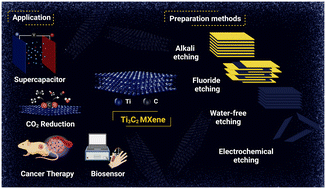2D MXene nanocomposites: electrochemical and biomedical applications†
Abstract
In recent years, key questions about the interaction of 2D MXene nanomaterials in electrochemical and biomedical applications have been raised. Most research has focused on clarifying the exclusive properties of the materials; however, only limited reports have described the biomedical applications of 2D nanomaterials. 2D MXenes are monolayer atomic nanosheets resulting from MAX phase ceramics. The hydrophilic properties, metallic conductivity, stability, and exclusive physiochemical performances make them promising materials for electrochemical and biomedical applications, including CO2 reduction, H2 evolution, energy conversion and storage, supercapacitors, stimuli-responsive drug delivery systems, regenerative medicine, and photothermal cancer therapy. In this review paper, we have provided facile approaches to synthesising MXene and characterization of chemical and physical properties. Their potential applications in medicine, ranging from antibacterial agents to targeted drug delivery, cancer photo/chemotherapy, tissue engineering, and electrochemical applications, have not been comprehensively reviewed and discussed—which encouraged us to come up with this work. We also discuss the most common challenges of utilizing MXene-related materials and areas that can be further developed in the future, with possible struggles and limitations one may face.



 Please wait while we load your content...
Please wait while we load your content...